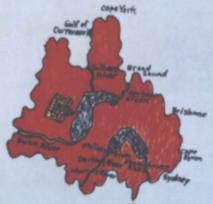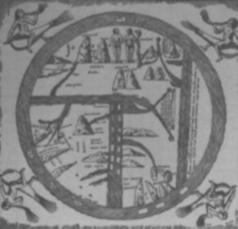Pyramids In The Pacific

The Unwritten History Of Australia
Chapter 20
|
Purgatory or Paradise? A Kangaroo at the mouth of Hell |
"Many folk want to make out the site of Paradise
is in the east of the earth, though cut off by the
longest intervening space of ocean or earth from
all regions that man now inhabits.
Consequently, the waters of the Deluge, which covered
the highest points of the surface of our orb, were
unable to reach it. However, whether it be there,
or whether it be anywhere else, God knows; but
that there was such a spot once, and that it was
on earth, that is certain".
Rabanus Maurus
on the location of Paradise
13th century.
|
Pyramids
in the Pacific Ch 20
|

|
Toscanelli World map 1471
So much written information and maps have been lost to us, that there is little wonder that conservative history teachers choose to ignore theories on ancient cultural diffusion. This reason is simple, much ancient knowledge was destroyed through the ravages of war, and the burning of ancient libraries either by accident or from religious ignorance and superstition; and much of what survived from the Classical Age was destroyed by the Catholic Church in the flames of its 'Holy ' Inquisition.
The Inquisition, or 'Holy Office" tribunal of the Church was formed for the discovery, repression and punishment of heresy. It gradually evolved from the 4th century and was finally established as a permanent institution in 1231. During this period, the Inquisition destroyed everything it considered to be pagan and threatening to Christian European culture. Before ancient copies of Ptolemy's maps were burned, some had been preserved in Constantinople and were taken to Baghdad in the 8th century, when Emir Al-Masur attempted to recover the ancient knowledge of European, Persian and Hindu Scholars.
11th century Arabic copies of Ptolemy's world map were stored in Moslem libraries, eventually resurfacing in Europe in 1409 when further European copies were produced. Official Church doctrine taught that the earth was flat and that it had four corners, exactly as the Bible said, although secretly a blind eye was turned for certain cosmographers and other scholars to have their own opinions, and produce maps of world globes which showed the true shape of the earth; so long as they were not too vocal about their findings!
The Greek scholar, Aristotle {384-322 BC} had said "The regions around the Pillars of Hercules are in connection with the regions around India, and between them there is nothing but sea". Strabo {64 BC-20 AD} maintained that, by sailing with an easterly wind in the western ocean a mariner "could reach the Indies". And about 120 AD, the Roman philosopher Favorinus wrote that the same ocean which the Greeks knew as the Atlantic Sea was known in East Asia as the Great Sea. Robert Bacon and Albertus Magnus put forward similar views in the 13th century. Crates of Malos, who built the first world globe in 150 BC, believed that many unknown continents lay in the great world ocean, and the same theory was held by learned Archbishop St. Isidore of Seville in the 7th century AD.
It was held also by the Arab Scholar Ibn Sina {or Avicenna in Europe} in the 11th century, and also by the Spanish philosopher and missionary Ramundus Lullus in the 13th. However, in the 14th century when Petrus of Albano and Cecco'd Ascoli dared to declare that the earth was round like a ball, the Church denounced them as heretics and they were burned at the stake! Similarly in 1600 when the Dominican monk, Giordano Bruno, wrote a book in which he declared there were an infinite number of suns in the universe, and planets which revolved around them, "some of which might be populated with beings much like ourselves", he was declared a heretic and burned alive at the Piazza del Fiore in Rome.
Indeed, by the dawn of the 16th century it had even become heresy to believe in the existence of a southern continent on a number of ridiculous grounds. Had the Church fathers taken the trouble to have a closer look at the Bible, they would have found a number of references to the existence of the "great south land".
AN 8th century world map from the Royal Library of Turin bears a Latin inscription:
Besides these three parts of the world there is a fourth part
beyond the interior ocean*, which on account of the heat of the
sun is unknown to us, and where may live the fabulous antipodeans".
{*ie the Indian Ocean supposed by some to be a Mediterranean
Ocean, hence the term "Interior ocean"}.
And St. Isidore of Seville, 7th century AD wrote of the southern continent:
The southern land occupies in size a quarter part of the world's ocean".

|
World Map Turin